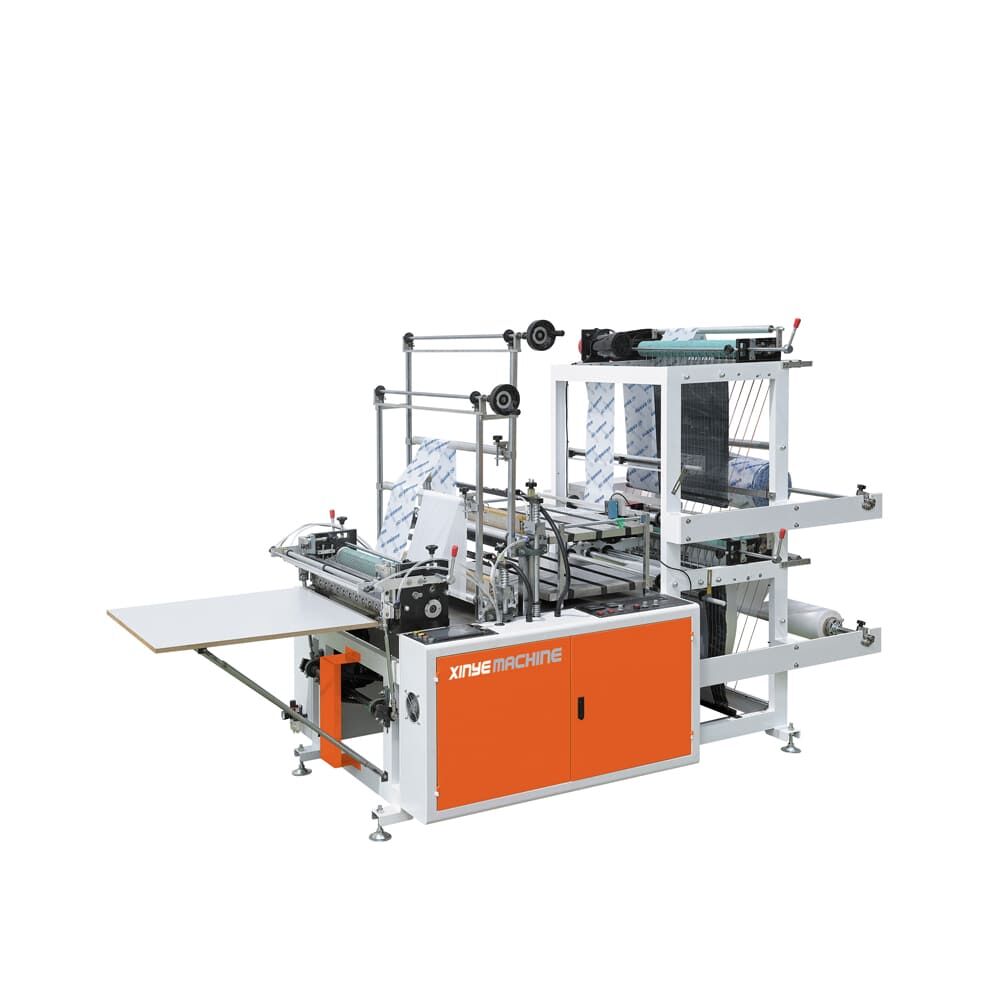Understanding High-Speed Bag Making Machines and Their Operational Impact
How Automated Bag Making Machines Enable High-Speed Packaging Operations
Today's bag making equipment can crank out around 3,400 bags every hour thanks to advanced servo-driven film feeding systems and automated pouch formation technology. The biggest advantage? These machines cut down on those pesky manual handling mistakes while keeping dimensions within a very narrow range of plus or minus 0.5mm. That kind of accuracy matters a lot when attaching zippers or creating those side gussets that give bags their extra capacity. Looking at real world data from eight different snack food companies, we find that facilities with full automation using vertical form fill seal (VFFS) machines typically finish orders about 34% quicker than places still relying on semi-automated processes. For businesses dealing with high volume production runs, this difference adds up fast.
Production Speed, Efficiency, and Benchmarks in Food and Retail Packaging Lines
The best bag making systems get judged by how many bags they produce per kilowatt hour, and some top models actually hit around 18.2 bags for those stand-up pouches. Getting to that sweet spot of 95% Overall Equipment Effectiveness means all the different parts of the line need to work together pretty much flawlessly. Bag makers have to sync up perfectly with fillers and then case packers too. Looking at some recent data from 2023 across 27 frozen veggie processing plants tells an interesting story. Plants that invested in these fast bagging machines which can switch sizes automatically saw their waste during product transitions drop by nearly two thirds. That's a big deal when talking about materials going to waste between different stock keeping units.
Key Innovations Reducing Downtime and Improving Overall Equipment Effectiveness (OEE)
Three core advancements enable OEE performance above 85%:
- Predictive maintenance algorithms that analyze motor current signatures
- Self-adjusting sealing jaws that compensate for film thickness variations
- Quick-release tooling allowing format changes in under five minutes
A 2023 OEE study showed these features improved production line availability by 18% in food packaging operations utilizing advanced automation.
Industry-Specific Applications of Bag Making Machines in Food and Retail
Bag Making Solutions for Snack, Dairy, and Perishable Food Packaging
Modern high speed bag makers focus on keeping things clean and accurate when packaging food items. When making snacks, these machines equipped with servo motors can crank out around 160 bags per minute and still manage to create those tight seals that keep products fresh longer on store shelves. Dairy products like cheese and yogurt require special handling too. The best machines work well with nitrogen flushing systems which stop the milk products from going bad due to air exposure. According to latest industry reports, improved tension controls help cut down on wasted plastic film by somewhere between 12% and 18%. Fresh foods get extra care through seal designs that avoid holes and handle anti fog films properly. This maintains what customers see through the packaging and keeps contents fresh as required by both FDA regulations and European Union food safety rules.
Customizable Machine Configurations for Diverse Product Formats and Retail Demands
Modular bag making systems can switch formats pretty quickly actually transitioning between those fancy stand up pouches for premium snacks, flat bottom bags that work great for pet food, and gusseted designs needed for bulk retail stuff all within about 15 minutes. The machines themselves are built to handle film thickness anywhere from 15 to 50 microns which means they can go from making thin bakery wraps to tougher reusable carrier bags without missing a beat. Plants that have adopted these auto calibration features typically see around a 22 percent boost in their overall equipment effectiveness when changing formats according to the latest Flexible Packaging Efficiency Index numbers from 2024.
Case Studies: Performance Gains in Real-World Food and Consumer Goods Workflows
A snack company from the Midwest managed to save around 14 percent on materials when they switched over to these new servo controlled machines that actually predict when films might tear during production. Meanwhile over in Europe, some dairy folks working together got really good results too their seals held up at an impressive rate of 99 point three percent across those eight million yogurt pouches they package every month thanks to better temperature control during sealing. And interestingly enough, stores that started using films with multiple layers saw complaints drop by nearly a third regarding how well products survived shipping according to last year's Global Retail Packaging Survey. These examples show just how important it is for different industries to find automated solutions that specifically address their unique quality concerns.
Optimizing Efficiency: Balancing Speed, Quality, and Sealing Performance
Measuring Performance with OEE in High-Speed Bag Making Environments
Overall Equipment Effectiveness (OEE) remains the benchmark for evaluating bag making performance, combining availability, performance, and quality. Top-tier food manufacturers achieve average OEE levels of 85% in optimized environments (IndustryWeek 2024), with predictive maintenance alone reducing unplanned downtime by 30%.
Servo-Driven Sealing Systems for Consistent, Wrinkle-Free Results
Servo-driven sealing technology eliminates manual adjustments, delivering consistent seal integrity at speeds exceeding 200 bags/minute. Compared to traditional pneumatic models, these systems reduce energy consumption by 10% while maintaining ±0.5mm positional accuracy— even with complex laminate films.
Fine-Tuning Dwell Time and Sealing Parameters in Vertical Form-Fill-Seal (VFFS) Machines
Precise control of dwell time (0.1–2.0 seconds) allows processors to tailor sealing settings for diverse materials, from 20µm metallized films to 150µ PE laminates. Real-world trials show that pairing infrared temperature monitoring with adaptive pressure control cuts film waste by 22%.
Resolving the Speed-Versus-Quality Trade-Off in Continuous Production
Torque-limiting drives and vision-based inspection systems enable continuous operation at 95% of rated speed without sacrificing seal quality. This balance is vital for perishable goods, where leak-free seals must exceed 99.9% to meet shelf-life requirements.
Scalability and Flexibility in Modern Bag Making Systems
The latest generation of bag making machines can boost production speeds by about 47 percent compared to what was available back in 2019, per the recent Bagging Equipment Efficiency Report from 2024. These newer machines feature servo driven systems that let operators tweak output levels up or down by around 30% pretty quickly, which comes in handy when there are sudden increases in demand like around holiday seasons or when launching new products. No need for any complicated mechanical changes either. The flexibility these machines offer really makes a difference in avoiding those frustrating inventory backups that happen so often during busy times in the business calendar.
Adapting Bag Making Machines to Fluctuating Retail Volumes and Market Growth
Advanced tension controls maintain sealing cycles under 150 ms even when processing ultra-thin 8–12 µm films—a common cost-saving strategy during economic downturns. This capability enables an 18% reduction in material costs (Packaging Digest 2023) while preserving required burst strength.
Machine Customization for Multi-Product Lines and Rapid Format Changes
Modular tooling has slashed SKU changeover times from 45 minutes to under 7 minutes over the past three years, as confirmed by the 2024 Industry Automation Survey. These hybrid configurations include:
| Modular Feature | Scalability Benefit | Flexibility Application |
|---|---|---|
| Interchangeable dies | ±30% output adjustment without downtime | Handle 5–7 bag styles per shift |
| Tool-less format change | 78% faster SKU transitions | Support 12+ materials annually |
This flexibility allows snack brands to switch between stand-up pouches and flat-bottom bags mid-run, eliminating $22,000 weekly in secondary packaging costs (Snack Food & Wholesale Bakery 2023).
Integrating Bag Making Machines into Existing Production Lines
Best practices for seamless integration with upstream and downstream equipment
Getting systems to work together properly begins by checking if all the mechanical parts and control systems can actually talk to each other. Plants that took time to do these compatibility checks when setting things up reported cutting down on unexpected stoppages by around 35%, according to last year's Packaging Systems Survey. When companies standardize how different machines communicate, it makes sharing information between them much smoother. Plus, having equipment designed in modules lets factories upgrade piece by piece without stopping everything cold turkey. Smart manufacturers often run through their entire workflow first to spot trouble spots before turning anything on. Think about mismatched conveyor belts running at different speeds or sensors fighting over control signals. Real world results back this up too. Some snack food makers who adopted better system compatibility saw their production get going again 18% quicker after making these connections happen.
HMI-driven recipe management and setup repeatability for fast changeovers
Modern HMIs store over 200 bag configurations with less than 1% recall error rate (2024 Automation Benchmarks), enabling operators to switch between retail-ready stand-up pouches and flat-bottom formats in under 90 seconds. Pre-programmed settings for film tension, sealing temperatures, and cutter positions eliminate calibration errors during transitions.
Advanced film handling techniques to maintain stability at high speeds
Servo-controlled tensioners and precision pre-stretch mechanisms achieve 99.2% film alignment accuracy (2023 Film Stability Index), crucial when running ultra-thin eco-friendly laminates at 160 bags/minute. Dual-sensor tracking compensates for memory effects in recycled films, reducing jams by 42% compared to legacy systems.
How bag style complexity affects VFFS machine throughput
Analysis of 57 production lines reveals that gusseted bags reduce VFFS speeds by 22% versus standard pillow pouches (Packaging Efficiency Report 2024). Multi-lane configurations counter this slowdown through parallel processing, preserving line balance when producing premium pouches with spouts or tear notches.
FAQ
What are the advantages of using automated bag making machines?
Automated bag making machines, equipped with advanced servo-driven systems, drastically reduce manual handling errors and achieve precise dimensions critical for zippers or gussets. They accelerate production by 34% compared to semi-automated processes.
How do modern bag makers impact waste reduction?
Modern bag making machines that can automatically switch sizes drastically reduce waste during product transitions, cutting it by nearly two-thirds, especially valuable in minimizing material wastage between stock keeping units.
Can bag making machines accommodate different types of food packaging?
Yes, modern machines are customizable to handle various bag styles and formats, including stand-up pouches, flat-bottom bags, and gusseted designs, catering to diverse retail demands and ensuring optimal freshness and safety.
How do servo-driven sealing systems benefit bag making processes?
Servo-driven sealing systems provide consistent seal integrity without manual adjustments, achieving speeds over 200 bags/minute with reduced energy consumption and maintaining positional accuracy.
How do advanced bag makers handle fluctuation in market demand?
These machines offer flexibility with quick output adjustments and format changes, allowing production scaling by around 30% swiftly, circumventing complex mechanical alterations and mitigating inventory backups, especially during peak seasons.
Table of Contents
- Understanding High-Speed Bag Making Machines and Their Operational Impact
- Industry-Specific Applications of Bag Making Machines in Food and Retail
- Optimizing Efficiency: Balancing Speed, Quality, and Sealing Performance
- Scalability and Flexibility in Modern Bag Making Systems
- Integrating Bag Making Machines into Existing Production Lines
-
FAQ
- What are the advantages of using automated bag making machines?
- How do modern bag makers impact waste reduction?
- Can bag making machines accommodate different types of food packaging?
- How do servo-driven sealing systems benefit bag making processes?
- How do advanced bag makers handle fluctuation in market demand?




